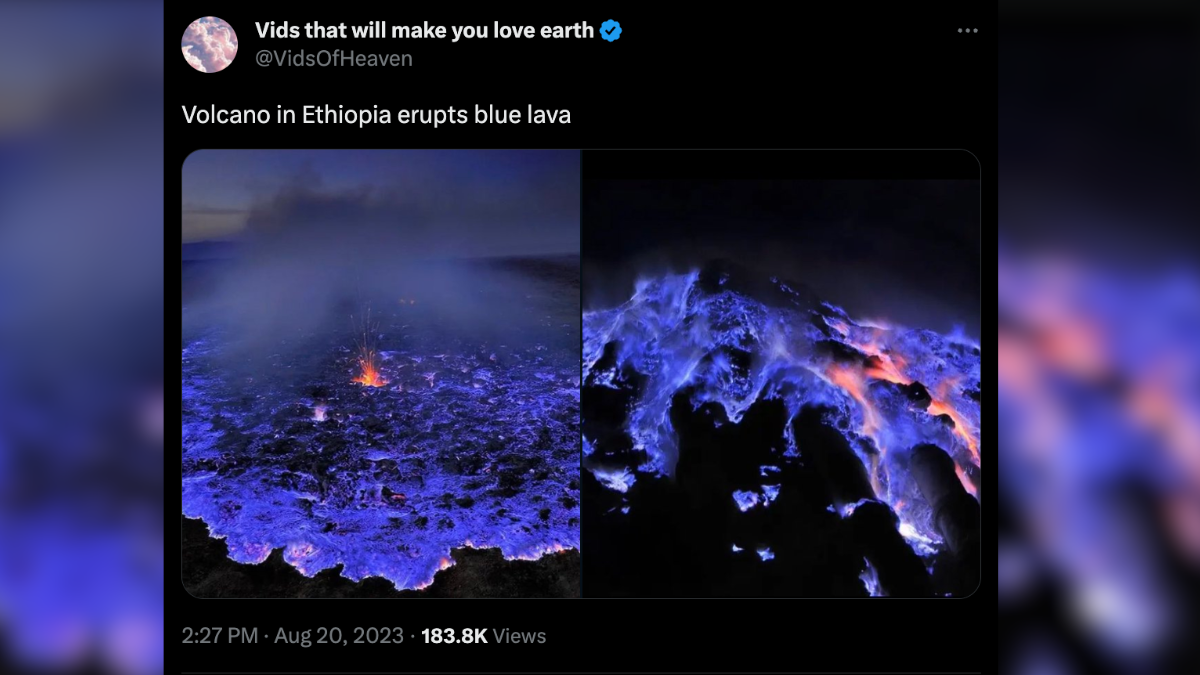Fact Check: Pics Show 'Blue Lava' Erupting From a Volcano in Ethiopia?

Claim:
Photographs shared to social media depicted a volcano in Ethiopia as it “erupts blue lava.”
Rating:
Context:
While the two photographs were authentic, they did not show “blue lava” erupting from a single volcano. Rather, the material that appeared blue was gas ignited by flames. Its dramatic coloration was caused by the combustion of sulfuric gas associated with volcanic activity. Also, one photo was taken in Indonesia, and the other — which was indeed taken in Ethiopia — showed a hydrothermal site, not a volcano.
Photographs supposedly documenting vibrant, blue-hued molten rock erupting from a volcano in Ethiopia were shared to X (formerly Twitter) on Aug. 20, 2023, (archived here). As of this writing, the post had been viewed more than 183,000 times:
Volcano in Ethiopia erupts blue lava pic.twitter.com/vxyxPKRSQ3
— Vids that will make you love earth (@VidsOfHeaven) August 21, 2023
While the two photographs were authentic, they did not show "blue lava" erupting from a volcano in Ethiopia, much less any other location. Rather, the material that appeared blue was gas ignited by flames. Its dramatic coloration was caused by the combustion of sulfuric gas associated with volcanic activity. Also, one photo was taken in Indonesia (right), and the other — which was indeed taken in Ethiopia — showed a hydrothermal site, not a volcano (left).
Hydrothermal sites are thermal systems that function muck like volcanoes, but their processes are primarily prompted by the heating of underground water. Some of the most well-known hydrothermal sites are located in the United States' Yellowstone National Park.
Through a reverse-image search, Snopes determined both photographs in question were originally taken by French photographer and filmmaker Olivier Grunewald in 2014. The photo of the Dallol hydrothermal site (located within the Danakil Depression) was first published in New Scientist on May 21, 2014. The photo of Indonesia's Kawah Ijen volcano was initially published in National Geographic on Jan. 30, 2023.
Those credible sources accurately captioned the photo, though many articles and posts republishing the images did not. The latter portrayed them as depicting "blue lava," which was simply not true, Grunewald told Snopes. "These blue flames are [created] by sulfuric gas combustion," he told Snopes by email.

(Images courtesy of Olivier Grunewald)
Looking at the in-question photos, Peter Kelly, a research geologist with the U.S. Geological Service Volcano Emissions Project, told Snopes via email, "The blue flames result from the burning of sulfur vapor associated with the native sulfur deposits formed from the reaction of H2S [hydrogen sulfide] and SO2-rich [sulfur dioxide] gases there."
When conditions at sites like Kawah Ijen and Dallol are just right, such environments can create a "natural sulfur factory." Gaseous H2S and SO2 form what is called native sulfur, which can be solid or liquid depending on the location's temperature and water-vapor levels. For example, above 110 degrees Celsius, native sulfur is liquid and can produce enough vapor to sustain flames at 160 degrees Celsius — a temperature otherwise known as the sulfur's "flash point." When mixed with air above 230 degrees Celsius, native sulfur can "auto-ignite" and create flames that are "brilliant blue," said Kelly.
There are anecdotal accounts of blue flames at other volcanoes around the world, including at Costa Rica's stratovolcano Turrialba and Mount St. Helens in Washington prior to its May 1980 eruption. Kelly wrote:
However, unlike Kawah Ijen, which has sustained native sulfur production for centuries, those volcanoes probably briefly passed through the field with the right combination of temperature and gas composition to make native sulfur and blue flames on their way toward eruption.
In other words, Kawah Ijen is the only known site in the world that has ignited blue flames for centuries. Meanwhile, the flames photographed at Dallol are only viewable under the right circumstances.
In short, while the two photographs featured in the X post were authentic, they did not show "blue lava" erupting from a single volcano in Ethiopia. Rather, the images showed blue flames, not molten rock, and the blue coloration was caused by the combustion of sulfuric gas. Furthermore, the images depicted two different locations and landforms: the Kawah Ijen volcano in Indonesia and Ethiopia's Dallol hydrothermal site. For those reasons, we rated this claim "Miscaptioned."
Sources:
#author.fullName}. "Ethiopia's Blue Volcano Burns Deadly Sulphuric Gas." New Scientist, https://www.newscientist.com/article/mg22229700-100-ethiopias-blue-volcano-burns-deadly-sulphuric-gas/. Accessed 22 Aug. 2023.
Cashman, Katharine V., and Joseph E. Taggart. "Petrologic Monitoring of 1981 and 1982 Eruptive Products from Mount St. Helens." Science, vol. 221, no. 4618, 1983, pp. 1385–87. JSTOR, https://www.jstor.org/stable/1691847.
Evon, Dan. "Snopes Tips: A Guide To Performing Reverse Image Searches." Snopes, 22 Mar. 2022, https://www.snopes.com/articles/400681/how-to-perform-reverse-image-searches/.
"Global Volcanism Program | Dallol." Smithsonian Institution | Global Volcanism Program, https://volcano.si.edu/volcano.cfm?vn=221041. Accessed 22 Aug. 2023.
"Global Volcanism Program | Ijen." Smithsonian Institution | Global Volcanism Program, https://volcano.si.edu/volcano.cfm?vn=263350. Accessed 22 Aug. 2023.
"Global Volcanism Program | Turrialba." Smithsonian Institution | Global Volcanism Program, https://volcano.si.edu/volcano.cfm?vn=345070. Accessed 22 Aug. 2023.
"Https://Twitter.Com/VidsOfHeaven/Status/1693419479256969346." Twitter, https://twitter.com/VidsOfHeaven/status/1693419479256969346. Accessed 22 Aug. 2023.
"National Geographic Photo Contest Winners." Photography, 14 June 2017, https://www.nationalgeographic.com/photography/article/photo-contest-gallery.
Olivier Grunewald | Bernadette Gilbertas - Accueil. https://www.oliviergrunewald.com/fr/. Accessed 22 Aug. 2023.
Peter Kelly | U.S. Geological Survey. https://www.usgs.gov/staff-profiles/peter-kelly. Accessed 22 Aug. 2023.
"Stunning Electric-Blue Flames Erupt From Volcanoes." Science, 30 Jan. 2014, https://www.nationalgeographic.com/science/article/140130-kawah-ijen-blue-flame-volcanoes-sulfur-indonesia-pictures.


